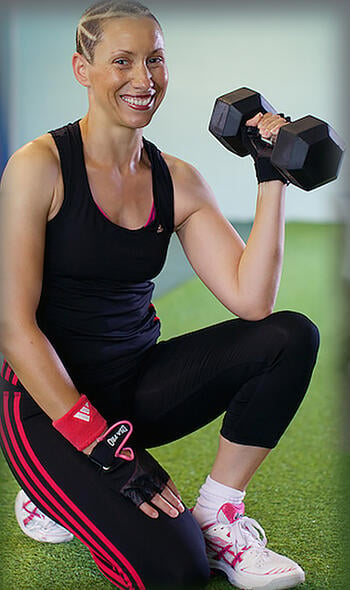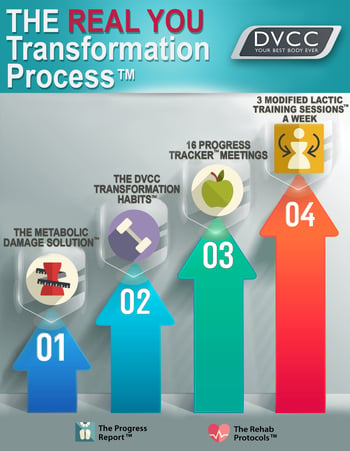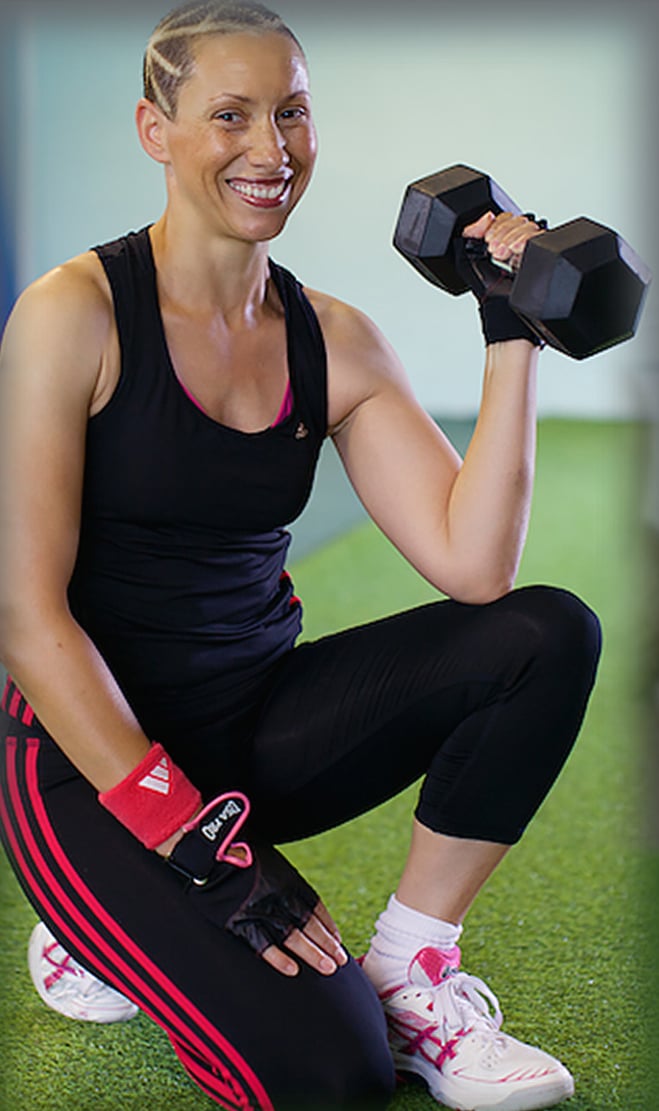Christina: This is Christina with the DVCC and today I’m joined with Josh, trainer at the DVCC’s Bedford location.  We’re going to discuss the benefits of the DVCC’s trademarked Modified Lactic Training.
We’re going to discuss the benefits of the DVCC’s trademarked Modified Lactic Training.
So how long have you been a personal trainer Josh, and how long have you been at the DVCC?
Josh: I’ve been a personal trainer for coming up to 6 years now and I’ve been with the DVCC for about 4 years.
Christina: A long time.
Josh: Yes, a fair while.
Christina: Can you please tell us a little bit about what Modified Lactic Training is?
Josh: Modified Lactic Training is the exercise vehicle by which all clients of the DVCC get the amazing results that you can see in our videos and on our website. So it’s not something that we’ve always done.
Years and years ago, our routines were planned a day in advance; now with Modified Lactic Training we plan our routines 6 months in advance and they follow a set pattern that ensures all of our clients maintain their results and can carry on getting results without ever plateauing.
Christina: Gosh, so 6 months planning in advance?
Josh: Yes.
Christina: Ok; why is this such a good form of training for weight loss?
Josh: For three reasons; the first one, the clue is in the name. We want to produce as much lactic acid as possible. When the body produces lactic acid, it will also produce something called growth hormone. Growth hormone is responsible for helping to build lean muscle tone and burn body fat. So that’s the first reason.
The second reason is that it will create a superior hormone profile; it will boost a hormone called testosterone which will help build lean muscle tissue again, and reduce the body’s stress hormone, which is cortisol. Cortisol is responsible for body fat storage specifically around the belly button area, so by reducing this it will actually work on reducing body fat around that area specifically.
And finally, it will create a large, post exercise, oxygen debt, or some of you may have heard of it as the afterburn effect. What this means is that, due to the elevated calorie burn in the recovery period for the training, that’s used to repair the muscles. It will actually mean that you’re burning calories at an elevated rate for about 48-72 hours after you finish a workout. So the true benefit is not entirely what you do during the workout, but the further reaching impact of what you do in that whole entire recovery period.
Christina: So let me get this straight; I can be working out and then burning calories while I’m sleeping or when I’m working, without doing anything else afterwards?
Josh: Yes, that’s absolutely true and that’s the difference between a high intensity training protocol like Modified Lactic Training and, for example, going out running. If you were to do a form of low intensity exercise, going for a long walk or something like that, you may burn a number of calories, but the body won’t be forced to burn any excess calories in that recovery period because you won’t be causing enough trauma to the muscles.
With the resistance training we do in Modified Lactic Training, we will indeed be burning calories at an elevated rate for a long time after the workout is finished.
Christina: You mentioned the word testosterone; I’m wondering if that might be a bit off-putting to any women listening to this interview?
Josh: I was actually waiting for you to come up with that one! The word testosterone is generally associated as a male hormone. Females do have testosterone and it’s important to maximise it, albeit, on average, females have around 20-30 times less testosterone than a male.
So despite the fact you will be using resistance, it will literally be impossible for a woman to build muscle in the same way as a man. So it is a myth that weight training can make you bulky as a woman, behind every female curve, so to speak, is muscle tone and that is what is going to give you a really toned, lean body shape.
Christina: So it’s not going to make us women bulky then?
Josh: No, not at all.
Christina: Ok. Is this the best form of training available for burning calories fast?
Josh: Yes, in Modified Lactic Training, there has been years and years of experience gone into this; both Mark and Stephen have contributed their decades of experience between them that has gone into this, and certainly at the DVCC, this has been a labour of love for the eight years that we’ve been here.
It is constantly evolving and we’ve refined it down to something now that is very, very successful and the testament to it is that our results have never been better.
Christina: Wow, that’s excellent. I’ve heard that the Modified Lactic Training is especially effective in groups. Is that right, do you tend to do this in groups or one on one?
Josh: The reason why we do a lot of things is not just based on ideas or conjecture; we put a lot of scientific research into what we do in terms of our training. It has actually been scientifically proved now that people get better results when they train in some form of group, whether that be small groups or larger groups.
 We’ve got two options at the DVCC for our Modified Lactic Training sessions; one being transformation camp, typically where the group is between 10-12, and our small group PT which is between 4-6. We can cater for either option there, and actually if you look at what athletes are doing, because athletes are at the forefront of training and nutrition, they are all training in small groups now and that is for the sole reason that it gets better results.
We’ve got two options at the DVCC for our Modified Lactic Training sessions; one being transformation camp, typically where the group is between 10-12, and our small group PT which is between 4-6. We can cater for either option there, and actually if you look at what athletes are doing, because athletes are at the forefront of training and nutrition, they are all training in small groups now and that is for the sole reason that it gets better results.
Christina: Why do you think that is?
Josh: Having had experience training people 1:1 in the past, it’s very easy to form a relationship with someone and, as that relationship develops, it’s easy to get caught up in conversation and you can’t push the other person as hard.
Naturally, when people are working in a group, it brings out a bit of competition in people and pushes people to train harder. I know at the DVCC, we’re fortunate enough to have a culture where everyone at the DVCC is training towards similar goals and has learned a lot along the way. Those people in the sessions are not just only there to train in the session; they are there to help you along the way.
It really puts a smile on my face when I’m doing a training session and I’m seeing someone who is perhaps new to the DVCC training with someone who might have been here for say 5 or more years and that person who has been here for a while is encouraging the new person to push themselves a bit harder or helping them with their technique if they’re struggling; that’s a really nice thing to see.
Christina: That’s nice, so it’s a very supportive way of doing it?
Josh: Yes, we’ve got very supportive community at the DVCC and everyone, as I said, is there working under the same goals and if we have helped people lose a lot of body fat and get into amazing shape, then they’re at their turn to pass their experience to other people. Because it’s nice to hear it from a client who has actually done it as well as the transformation experience and client experience managers that you see at the DVCC centres.
Christina: I’m sure that’s a good motivator for people as well.
Josh: Yes of course.
Christina: What does a sample workout look like? Is there a typical sample?
Josh: As I mentioned before, we have 6 months of training planned out in advance; that follows a specific pattern, so we have alternating what’s called accumulation and intensification phases. Each of these has their own individual goals.
The goal of an accumulation phase is to build as much volume as possible, so as many repetitions as possible in the workout. Then, every 4 weeks we change the phase, so we change to an intensification phase, where our primary goal would be to build strength. By alternating these phases, we make sure that no-one’s body ever gets used to any of our workouts and of course it means that no-one ever gets bored because it means the workouts are constantly changing.
So no two workouts that anyone does at the DVCC will ever be the same. And by alternating these phases, we ensure people keep progressing and literally they can follow the model. So we know that if someone comes in at day 1, they can follow this system and progress as has every other client.
In every DVCC centre, this is the same, so we have clients train at all three of our centres – soon to be more – and so they rely on that consistency and know that whichever centre they go to, they’re going to get the same amazing standard of training.
Unlike going to a commercial gym, where you would go in and pick the personal trainer who would best suit your needs, for example, we train all of our team to be able to deliver these sessions to the same, exact, very high standard. That consistency creates confidence.
Christina: That’s brilliant too, for those people who are travelling round the country and need to go to a different centre, they know they can go in and get on with the same workout.
Josh: Yes, I think it’s really important. We do have a lot of clients that travel and to know that wherever they are in the country, they’re able to get an amazing workout is a really good thing for them.
Christina: You mentioned something about changing the routine so the body doesn’t get used to doing the same exercise. What’s the problem with the body getting used to doing the same repetitive exercise?
Josh: The human body is a very clever thing; it’s called the law of accommodation. If we were to do something over and over again, the body would very quickly learn to do that much more efficiently.
In the case of a workout, for example, if we were to do the same workout over and over again and it’s something that I frequently see with a lot of people who join the DVCC, because the information simply isn’t out there. They’ve done the same thing over and over, and their results are suffering because of that. And it’s because of this law of accommodation; for example, if we were to go for a run: you would need to either run faster or do it in a short time, or to run further, to keep making your results sustainable.
The fact that we change the workout every day and then change the phase means that we don’t fall into this trap of people getting used to the workouts. So what tends to happen when we put a new phase out there is that it’s a big shock to the body in the first week; I’m sure you can ask any DVCC client, the first week of a new phase is always a tough one.
Then, for the next few weeks they start to get used to it and then, just when they’re starting to get used to it and getting comfortable, we’ll change the phase and that will really shock their body; it means that the results carry on improving.
Christina: Speaking of results, how long does it take to notice results and what kind of results can people expect to see, short term and long term?
Josh: We know at the DVCC, you’re not going to get results simply by training; you’re going to have to do some sort of nutrition protocol along with that; so for all our new clients at the DVCC, we have designed – and again this has been something that’s evolved over the years that we’ve been here – something called the Metabolic Damage Solution.
It’s a very, very good way of losing body fat initially. We combine the training with this Metabolic Damage Solution for all new clients and it’s not unrealistic to see people lose body fat in the region of 12-14lbs in the first 4 weeks, if they follow the nutrition properly.
Christina: MLT, talking of nutrition, is complemented by the DVCC’s Real You Transformation Process; can you tell us a bit about that? 
Josh: Yes, sure. What we’ve done over the years is boil everything we do down into a process. Rather than just figuring out with every individual person and doing something different, we know that by following this process, people are going to get the same predictable results.
That’s important because people, as I said, get confidence from having this consistency so they know that if they follow this process they can expect the same results as people they’ve seen in the centre and in our videos on our website.
We always start out with the Metabolic Damage Solution, which is not only a nutrition protocol, so it’s not only going to be the best way to lose body fat, but it is also the best way of preventing illness and disease as well. Unfortunately, it would take me a long time to go through in detail what it is, but suffice to say it’s a nutrition protocol that runs alongside the training.
Christina: Perhaps you can give us a snapshot of what kind of a diet we would be eating on this programme?
Josh: I don’t like to use the word diet; diet is almost something transitory; you read in magazines, 6 week diet, 8 week diet. I think that therein lies the problem; it’s something that you’re going to do only for a short period of time.
I don’t believe fitness should be that way; people have got the rest of their lives to lose body fat, be healthy; so I think what we do at the DVCC is give people something that is able to be maintained for the rest of their lives.
I prefer to use the word habits; think of a habit like brushing your teeth; you do it every morning, every evening. I’ve just got back from holiday and I followed the same habits there, so it doesn’t matter where you are, what your circumstances are, you are going to be able to follow these habits.
We like to give people nutritional habits to follow, so when they build on each other it becomes a lot more sustainable. It’s not just a diet that some people are doing; it’s literally changing their lives and transforming their everyday routine.
The best first habit for most people would be to eat a high protein breakfast in the morning. A good example of that would be an omelette; it’s full of healthy fats, so definitely include the yolks in there, throw in as many fibrous vegetables as you want: broccoli, kale, spinach; have it on the side: peppers, mushrooms.
There are a million and one different ways to make omelettes, so you can really make it different every day and ensure you won’t get bored. So having something high protein and healthy fat in the morning is going to help your blood sugar rise very slowly in the morning.
So you are less likely going to suffer from sugary cravings or anything like that; you’re going to be fuller for longer and also, in terms of people going out to start their day at work, it’s going to help certain neurotransmitters in the brain, acetylcholine being one of them and dopamine being the other, work very well, you’ll be very switched on. So it’s not just a nutrition thing, it will help concentration and focus and all of those good things.
Christina: Excellent; I find it very interesting that you call it habits.
Josh: Yes, I think it’s important that people see it that way because fitness shouldn’t be something that you do for 8 weeks, it should be something you maintain for the rest of your life.
Christina: To make it sustainable, how many times a week would people have to train at the DVCC?
Josh: The way we structure our Modified Lactic Training is that clients can come as many times as they want during the week. We recommend three to five sessions to truly see life changing results. That’s how many sessions most of our clients do and I know from past experience, sometimes if people have time off work they can train twice a day; the programmes are structured so that they will be able to do that.
So as long as they’re eating correctly, which we will ensure, and sleeping correctly which is part of the monitoring process of the Real You Transformation process, we’ll be making sure both those things are true, then it won’t lead to over-training.
Christina: So you’re giving people time to recover between workouts.
Josh: Exactly.
Christina: I think we’ve already covered this, but are there any other benefits of this training, besides burning fat? You mentioned better concentration; anything else?
Josh: Yes; due to the superior hormone profile, it will help concentration, it will reduce stress; all of those things are required to just generally have a higher output in life. I think a lot can be spoken for reducing stress, certainly in modern day life; it’s been scientifically proven that we’re far more stressed these days than we were a hundred years ago. Anything we can do to reduce stress will be very, very helpful and this has far reaching benefits.
One that some people listening might be able to relate to is sleep; these days a lot of people are sleeping worse and that’s due to the stress hormone, cortisol. What’s meant to happen is cortisol is meant to be very low before you go to bed and consequently very high in the mornings; so you drift off very easily to sleep, you sleep unbroken, nice, deep sleep and then wake up and you’re ready to go in the morning.
These days, it tends to be the opposite way round, a lot of people’s cortisol levels will be very high in the evenings, possibly due to a stressful day, so they will struggle to get to sleep, they’ll probably have very broken sleep and will wake up several times during the night, and then in the morning they might be very tired and end up hitting snooze a lot. If you’re listening and you find yourself doing this, then certainly reducing that stress hormone cortisol is going to be something that really, really helps.
Christina: That sounds pretty motivating to me but I was going to ask, apart from that, how do you do your best to motivate people on the programme, I’m sure that at times people struggle to get down to the gym; how do you keep them motivated?
Josh: At the DVCC, we’re a results based centre so we judge ourselves on our own results and we are judged on our results. Anyone who has taken a look on our website knows that we’re very proud of the results we achieve with all of our clients.
So it’s definitely in our interests to make sure everyone comes in as often as possible and follows the programme. We want everyone to be displayed proudly on the walls of the DVCC and on our website - that’s why clients come to us in the first place, because we are literally the best results based centre.
For example, if I don’t see someone, if they’re booked into the training diary and we don’t see them, or if they’re away for a few days in a row, certainly we’ll be contacting them to make sure they’re coming in, to make sure they’re getting the most out of their workouts.
Christina: Ok, that’s great. This training, is it suitable for absolutely everybody or is there anybody that can’t do this or shouldn’t do this?
Josh: In the years that I’ve been at the DVCC, we’ve used this process with any number of different people. I’ve trained young people from the age of 11, the youngest person I’ve trained, right up to people in their 70s; men, women of all different ages and sizes. Even pregnant ladies, I’ve trained up until month 7, month 8 of their pregnancy.
Obviously there will be things that we need to adapt for specific cases: perhaps some people have got injuries; but the advantage of the Modified Lactic Training sessions is that we’ve programmed in adaptations for those people.
So if someone comes to us with a knee problem, we have a specific adaptation in the routine to address the knee problem. And then, as a part of the Real You Transformation process, we do have rehab protocols that will actually deal with the knee problem itself. We don’t like to tiptoe around the injury, but rather tackle it head on and fix it, so that people don’t have to suffer from the injury any more.
Christina: Brilliant, so you don’t have to be left out at all, even if you’ve been injured or if you’re pregnant.
Josh: The aim of the Real You Transformation process is to address all those obstacles that people might normally face when it comes to achieving the transformations they’ve always wanted. So, in terms of keeping people on track, part of the process that’s built in is a regular meeting called the Progress Tracker.
It’s something that all of our clients take advantage of; we do it between every week and three weeks, depending on what’s more supportive for their results. When we get them measured on our special body fat machine, that’s how we keep a track of all our clients’ results, we can monitor that so it will be sent to the client’s phone so they can monitor their results wherever they go.
If results ever don’t go the way that we want them to go, then we have some software, called the focus habit software, that will ask a series of questions and determine what would be the smallest habit for a particular client to start doing that would get their results moving in the right direction.
So you know that even if you don’t get the results you want one week, you’re going to be leaving feeling confident that you’ve got the answer to make sure it doesn’t happen again.
Christina: That’s great. Josh, you mentioned that you had quite a lot of success stories and you’ve got members of the DVCC that have been with you for years; can you think of any particular success story that really comes to mind when talking about MLT?
Josh: Yes, begrudgingly. The person in mind, his name is Kevin Shurrock, he’s already got his head up in the clouds - he’s somewhat of a celebrity at the DVCC - I think that’s a bit of a self made celebrity as well!
So, Kevin I’ve trained now for three years and the change I’ve seen in him is quite staggering. He’d be annoyed at me if I didn’t mention that he’s lost just shy of 70lbs of fat since he’s been at the DVCC, which is a huge number and he’s literally transformed his life.
He started at the DVCC, and I’m sure he won’t mind me saying this, in the mid forty percent range body fat; he’s now at about eighteen percent body fat, which is fantastic and to see the change in him as he’s gone along is amazing.
Christina: That’s incredible – sorry, I didn’t hear quite exactly the number, how much he lost?
Josh: Just shy of 70lbs of fat – a huge, huge number.
Christina: Oh wow! It sounds amazing. Just a couple of things then: is there any special equipment that I need to invest in to come down to the DVCC?
Josh: No, not at all. All you need to do to come down to the DVCC is wear anything that you feel comfortable to exercise in: trainers would be advisable. And just bring yourself, bring a smile, we’ll take care of everything for you.
All you need to do is come down, it doesn’t matter whatever your level of exercise; all of our equipment that we have at the DVCC is custom made for us, for Modified Lactic Training and to get the best results. We’ve streamlined it so we only have the best equipment and the necessary equipment to achieve the best results. All you need to do is get down here and leave us to take care of the rest.
Christina: Brilliant. The DVCC has centres in Bedford, Milton Keynes, Northampton and Hitchin – and as Josh mentioned, very shortly in Stevenage and central Bedfordshire.
So if you’ve been listening to this interview and you’d like to find out more about how the DVCC can help you, then please book an appointment for a DVCC Right Fit phone call at www.theDVCC.com/signup.









